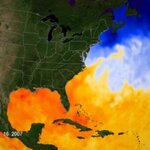Atmospheric

Sea surface temperatures are one of the key ingredients for tropical cyclone formation and they were warming up in the Gulf of Mexico, Caribbean and eastern Atlantic Ocean by the middle of August. As a result, they helped spawn Hurricane Dean in the central Atlantic, and Tropical Storm Erin in the Gulf of Mexico, both during the week of August 13.
By late June, sea surface temperatures in the Gulf of Mexico were all over 80 degrees Fahrenheit. That's one thing that hurricane forecasters watch for because sea surface temperatures of 80 degrees Fahrenheit or warmer are needed to power tropical…

A recent Newsweek magazine cover story on global warming contained significant errors and used outdated scientific material in its representation of global climate data collected by satellites, according to the scientists who maintain that dataset at The University of Alabama in Huntsville.
Dr. John Christy and Dr. Roy Spencer, who created and maintain the global temperature dataset, recently addressed how instruments aboard NOAA satellites collect temperature data and about the accuracy of that data. The most recent monthly update of global temperatures shows a warming trend of about 0.25°…

The length of heat waves in Europe has doubled and the frequency of extremely hot days has nearly tripled in the past century, according to new research. The new data shows that many previous assessments of daily summer temperature change underestimated heat wave events in western Europe by approximately 30 percent.
Paul Della-Marta and a team of researchers at the University of Bern in Switzerland compiled evidence from 54 high-quality recording locations from Sweden to Croatia and report that heat waves last an average of 3 days now—with some lasting up to 4.5 days—compared to an average of…

About twice as many Atlantic hurricanes form each year on average than a century ago, according to a new statistical analysis of hurricanes and tropical storms in the north Atlantic. The study concludes that warmer sea surface temperatures (SSTs) and altered wind patterns associated with global climate change are fueling much of the increase.
"These numbers are a strong indication that climate change is a major factor in the increasing number of Atlantic hurricanes," says Greg Holland of the National Center for Atmospheric Research (NCAR).
The analysis identifies three periods since 1900,…

Large quantities of ozone-depleting chemicals have been discovered in the Antarctic atmosphere by researchers from the University of Leeds, the University of East Anglia, and the British Antarctic Survey, but sea salt and algae are more to blame than mankind, say researchers.
The team of atmospheric chemists carried out an 18-month study of the make-up of the lowest part of the earth's atmosphere on the Brunt Ice Shelf, about 20 km from the Weddell Sea. They found high concentrations of halogens - bromine and iodine oxides – which persist throughout the period when there is sunlight in…

Experts from the Met Office, the University of Exeter and the Centre for Ecology & Hydrology, have found that projections of increasing ozone near the Earth’s surface could lead to significant reductions in regional plant production and crop yields. Surface ozone also damages plants, affecting their ability to soak up carbon dioxide from the atmosphere and accelerating global warming.
Near-surface ozone has doubled since 1850 due to chemical emissions from vehicles, industrial processes, and the burning of forests. Dr Stephen Sitch, a climate impacts scientist at the Met Office Hadley…

In Earth's long history, its climate has changed many times. This was because orbit parameters altered, continents and oceans shifted, large asteroids fell and volcanoes began to erupt.
In the last decade of the 20th century, the scientific community began to discuss one more possibility for climatic changes, which are long-term in terms of human history and quick in terms of geological time scale.
They called this a “methane catastrophe”, a discharge of large quantity of methane from gas hydrates located in the interior of the Earth. As a result, the climate got warmer within 15-30,000…

Fossilised midges have helped scientists at the University of Liverpool identify two episodes of abrupt climate change that suggest the UK climate is not as stable as previously thought.
The episodes were discovered at a study in Hawes Water in Northern Lancashire, where the team used a unique combination of isotope studies and analysis of fossilised midge heads. Together they indicated where the climate shifts occurred and the temperature of the atmosphere at the time.
The first shift detected occurred around 9,000 years ago and the second around 8,000 years ago. Evidence suggests that…
A team of international researchers has collected the oldest ever recovered DNA samples and used them to show that Greenland was much warmer at some point during the last Ice Age than most people have believed. Their findings also confirm that the whole ice sheet will not melt and bring about the tremendous sea-level rises which have been the subject of so much discussion.
The ancient DNA was discovered at the bottom of a two kilometer thick ice sheet and came from the trees, plants and insects of a boreal forest estimated to be between 450,000 and 900,000 years-old. Previously, the youngest…
NASA's Tropical Composition, Cloud and Climate Coupling (TC4) field campaign will begin this summer in San Jose, Costa Rica, with an investigation into how chemical compounds in the air are transported vertically into the stratosphere and how that transport affects cloud formation and climate.
The study will begin the week of July 16 with coordinated observations from satellites, high-flying NASA research aircraft, balloons and ground-based radar. The targets of these measurements are the gases, aerosols and ice crystals that flow from the top of the strong storm systems that form over the…